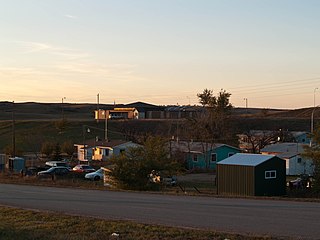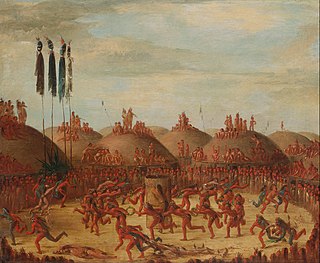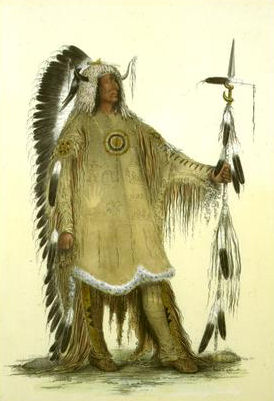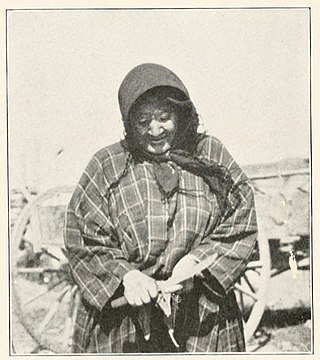
Mandaree is a census-designated place (CDP) in McKenzie County, North Dakota, United States. The population was 596 at the 2010 census.
The Mandan, Hidatsa, and Arikara Nation, also known as the Three Affiliated Tribes, is a Native American Nation resulting from the alliance of the Mandan, Hidatsa, and Arikara peoples, whose native lands ranged across the Missouri River basin extending from present day North Dakota through western Montana and Wyoming.

The Hidatsa are a Siouan people. They are enrolled in the federally recognized Three Affiliated Tribes of the Fort Berthold Reservation in North Dakota. Their language is related to that of the Crow, and they are sometimes considered a parent tribe to the modern Crow in Montana.

Arikara, also known as Sahnish, Arikaree, Ree, or Hundi, are a tribe of Native Americans in North Dakota. Today, they are enrolled with the Mandan and the Hidatsa as the federally recognized tribe known as the Mandan, Hidatsa, and Arikara Nation.

The Mandan are a Native American tribe of the Great Plains who have lived for centuries primarily in what is now North Dakota. They are enrolled in the Three Affiliated Tribes of the Fort Berthold Reservation. About half of the Mandan still reside in the area of the reservation; the rest reside around the United States and in Canada.

The Fort Laramie Treaty of 1851 was signed on September 17, 1851 between United States treaty commissioners and representatives of the Cheyenne, Sioux, Arapaho, Crow, Assiniboine, Mandan, Hidatsa, and Arikara Nations. Also known as Horse Creek Treaty, the treaty set forth traditional territorial claims of the tribes.
United Tribes Technical College (UTCC) is a private tribal land-grant community college in Bismarck, North Dakota. In 2012, UTTC had an enrollment 885 students, 635 full-time undergraduates, and 250 part-time undergraduates.
Lone Fight is a broad family name related exclusively to the Mandan, Hidatsa, and Arikara Nation of the Fort Berthold Reservation in North Dakota.

The Hunkpapa are a Native American group, one of the seven council fires of the Lakota tribe. The name Húŋkpapȟa is a Lakota word, meaning "Head of the Circle". By tradition, the Húŋkpapȟa set up their lodges at the entryway to the circle of the Great Council when the Sioux met in convocation. They speak Lakȟóta, one of the three dialects of the Sioux language.

The Fort Berthold Indian Reservation is a U.S. Indian reservation in western North Dakota that is home for the federally recognized Mandan, Hidatsa, and Arikara Nation, also known as the Three Affiliated Tribes. The reservation includes lands on both sides of the Missouri River. The tribal headquarters is in New Town, the 18th largest city in North Dakota.

Like-a-Fishhook Village was a Native American settlement next to Fort Berthold in North Dakota, United States, established by dissident bands of the Three Affiliated Tribes, the Mandan, Arikara and Hidatsa. Formed in 1845, it was also eventually inhabited by non-Indian traders, and became important in the trade between Natives and non-Natives in the region.
William Harjo LoneFight, is president and CEO of American Native Services, a consulting firm in Bismarck, North Dakota.

Mato-tope was the second chief of the Mandan tribe to be known as "Four Bears," a name he earned after charging the Assiniboine tribe during battle with the strength of four bears. Four Bears lived in the first half of the 19th century on the upper Missouri River in what is now North Dakota. Four Bears was a favorite subject of artists, painted by George Catlin and Karl Bodmer.

Waheenee, also referred to as the Buffalo Bird Woman was a traditional Hidatsa woman who lived on the Fort Berthold Reservation in North Dakota. Her Hidatsa name was Waheenee, though she was also called Maaxiiriwia. She was known for maintaining the traditional lifestyle of the Hidatsa, including gardening, cooking, and household tasks. She passed on the traditional ways of her culture and oral tradition through interviews with Gilbert Wilson, in which she described her own experience and the lives and work of Hidatsa women.
Twin Buttes is an unincorporated community in Dunn County, North Dakota, United States. It is a community on the Fort Berthold Indian Reservation, which is home of the Mandan, Hidatsa, and Arikara Three Affiliated Tribes. Twin Buttes is 2 miles (3.2 km) south of Lake Sakakawea, and 12 miles (19 km) north-northeast of Halliday.
Alyce Spotted Bear was a Native American educator and politician and an enrolled member of the Mandan, Hidatsa, and Arikara Nation.
Ruth Anna Buffalo is an American politician who served as a member of the North Dakota House of Representatives from the 27th District, serving from December 1, 2018. She is the first Native American Democratic woman elected to the North Dakota Legislature.
Denby Deegan, also known as Surrounded by Enemy, was a notable Native American architect in the United States and a founding member of the American Indian Council of Architects and Engineers. Deegan was a member of the Three Affiliated Tribes, known as the Mandan, Hidatsa, and Arikara Nation, and his architectural and design work focused on themes and motifs from his culture and heritage.
Raymond "Ray" Cross was an American attorney and law professor from the U.S. state of North Dakota. He was a member of the Mandan, Hidatsa, and Arikara Nation, also known as the Three Affiliated Tribes, and a former professor of American Indian Law at the University of Montana. As an attorney, Cross represented Native Americans in multiple landmark trials, including two U.S. Supreme Court cases, and successfully won a compensation claim against the U.S. government for the flooding of 156,000 acres of tribal land in North Dakota due to the construction of the Garrison Dam.
Elbowoods is a ghost town that was located in McLean County, North Dakota, United States, on the Fort Berthold Indian Reservation. It was founded in 1889 along the Missouri River as the agency seat for the reservation of the Mandan, Hidatsa, and Arikara Nation. After the creation of the Garrison Dam and Lake Sakakawea, rising water levels threatened the town, slowly engulfing its buildings until the entire town was submerged in 1954.